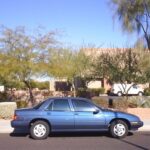Headlights are one of the most important safety features on your car, but they can only do their job if they’re properly maintained. It’s not just burned out headlights that cause problems; headlights that are dim or incorrectly aligned can also lead to accidents. Fortunately, learning how to repair headlights is something even the least mechanically inclined person can do. When you know how to repair headlights yourself, you can save up to several hundred dollars on mechanic’s fees. Here are some tips on how to repair headlights with common problems.
Headlights that don’t turn on
If you’re headlights aren’t working at all, the most likely cause is a burned out bulb. All you need to do to repair the headlights is replace the bulb. If you have plastic lenses, you can take out the old bulb by removing the lens and unscrewing the bulb from the back of the lens. With glass headlights, though, you’ll need to replace the whole glass. Since you’re buying new bulbs anyway, consider picking up one of the new, brighter types of bulbs, such as the halogen or xenon types. Osram Sylvania’s SilverStar brand is an especially popular model. These can greatly improve nighttime visibility.
When you’ve got your replacement bulb, install it and turn on the lights. If the headlights still don’t work, it’s a sign of an electrical problem. Because electrical problems are relatively complicated to repair, take your car to a mechanic before you try to do anything else with the headlights.
Headlights with yellow or dim lenses
Dirty, yellowed, cloudy and otherwise dim headlights are another common problem. Unlike a burned out bulb, yellowing headlight lenses make your lights dimmer slowly over time, so they’re easier to ignore. The limited field of vision they cause can be just as dangerous, though. The easiest way to repair headlights with yellow or cloudy lenses is to use lens polishing compound (also called rubbing compound). The usual method is to rub the lens with wet, fine-grain (1000 grit) sandpaper first. For major damage, you may need to use a courser grain of sandpaper, even up to 5000 grit. Then polish the lens with a course (red) polishing compound followed by a fine (white) compound. When you’ve finished polishing, clean the lens with Armor All or Simple Green. While polishing usually works, some lenses may be beyond repair and need to be replaced.
Water in the lens
If you have water in your lens, you’ll need to get the water out before repairing the leak. For plastic lenses, remove the lens and then carefully drill a small hole into the bottom of the lens. Let the water drain out and fill the hole in with silicone, urethane, or plastic resin. Of course, if you don’t find the original leak and repair the headlight, eventually more water will collect in it. If you find a crack or hole in the lens, you can repair it with the same product you used to patch the drainage hole. Another possible source of leaks is a break in the seal around the headlights. These seals can be repaired with silicone.
Misaligned headlights
Properly aligned headlights should be aimed a little bit low. Incorrect installation, fender benders, or rough driving conditions can knock headlights out of alignment. This misalignment increases glare for you and oncoming drivers and impairs your depth perception, so it’s worth your time to repair headlights that have this problem.
It’s simple enough to repair your headlight alignment at home, though. All you’ll need is a flat vertical surface, tape, a tape measure and a screwdriver. Drive your car up to a surface like the garage door and park it there with the low beams on. Use tape to mark the horizontal and vertical centerlines of where each light hits. (That is, mark the center of the light beam with a + sign.) Next, back the car up to about 20 feet away and park it facing straight at the surface you marked. Now turn on the high beams. The centers of each light beam should fall about 2 inches below the horizontal line and be vertically centered or aimed a little to the right. If your headlights are out of alignment, use the top and side adjusting screws on the headlights to alter the alignment until you get it where you want it.
Although headlight problems are sometimes caused by electrical faults that need professional repair, most problems are simpler to fix. Even if you’re not all that handy with cars, you can learn how to repair headlights in very little time. A burned out bulb is easy to replace and yellow headlight lenses can be cleaned with easy-to-find products. Learn how to repair headlights yourself and you’ll not only improve the safety of your vehicle, you’ll save money on maintenance, too.


